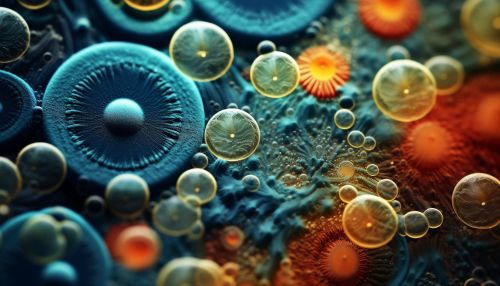Microbial metabolism
Overview
Microbial metabolism refers to the various biochemical reactions that occur within microorganisms, including bacteria, archaea, viruses, and fungi. These reactions are crucial for the survival and growth of these organisms, and they also play a significant role in the global cycling of elements.
Types of Metabolism
Microorganisms exhibit a wide range of metabolic types. These can be broadly classified into two categories: catabolic and anabolic reactions.
Catabolism
Catabolism involves the breakdown of complex organic molecules into simpler ones, releasing energy in the process. This energy is then used to drive various cellular processes. The most common catabolic processes in microorganisms include glycolysis, the Krebs cycle, and oxidative phosphorylation.
Anabolism
Anabolism, on the other hand, involves the synthesis of complex molecules from simpler ones, requiring energy. This includes the synthesis of proteins, nucleic acids, and lipids, among others.


Metabolic Diversity
Microorganisms exhibit a remarkable diversity in their metabolic capabilities, which allows them to inhabit a wide range of environments.
Autotrophs
Autotrophic microorganisms are capable of synthesizing their own organic compounds using inorganic substances. They can be further classified into photoautotrophs, which use light as an energy source, and chemoautotrophs, which derive energy from inorganic chemical reactions.
Heterotrophs
Heterotrophic microorganisms, on the other hand, obtain energy by consuming organic compounds produced by other organisms. They include saprophytes, which feed on dead organic matter, and parasites, which derive nutrients from living hosts.
Metabolic Pathways
Microorganisms utilize a variety of metabolic pathways to convert nutrients into energy. These pathways can be broadly classified into three categories: glycolysis, the Krebs cycle, and the electron transport chain.
Glycolysis
Glycolysis is a series of reactions that convert glucose into pyruvate, generating a small amount of ATP in the process. This pathway is common to nearly all organisms.
Krebs Cycle
The Krebs cycle, also known as the citric acid cycle, is a series of reactions that further oxidize the products of glycolysis to produce ATP, NADH, and FADH2. This pathway is common to aerobic organisms.
Electron Transport Chain
The electron transport chain is a series of protein complexes located in the inner mitochondrial membrane that use the energy stored in NADH and FADH2 to pump protons across the membrane, creating a proton gradient. This gradient is then used to drive the synthesis of ATP.
Role in Biogeochemical Cycles
Microbial metabolism plays a crucial role in the cycling of elements on Earth. For example, bacteria and archaea play a key role in the nitrogen cycle, converting atmospheric nitrogen into a form that can be used by plants. Similarly, microorganisms are involved in the carbon cycle, converting carbon dioxide into organic compounds through photosynthesis and releasing it back into the atmosphere through respiration.
